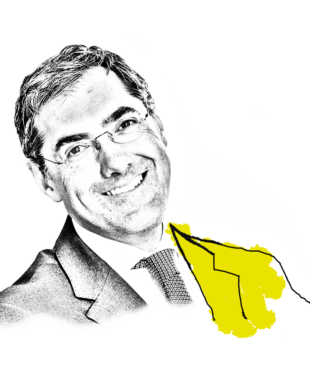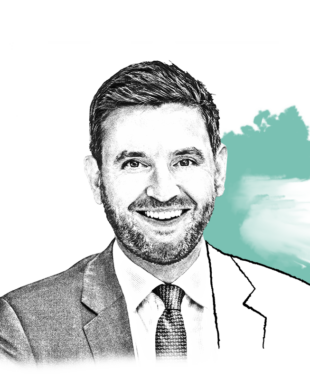The Covid-19 pandemic and new urgency around climate change are shining a spotlight on investment risk and exposure. But are they changing how Walter Scott thinks about its portfolio? Three members of the team tell us about the firm’s approach, how disclosure is getting more important, and why data might not be all it is cracked up to be.
How would you describe the Walter Scott approach to investment risk?
Charlie Macquaker, Executive Director – Investment: Our principal mindset is to protect our client’s hard-earned savings and capital. Secondly, we’re investing in companies, so we need to understand their ability to deliver on our objective in terms of delivering 7–10% real rates of annualised return over time. So, the risk from a portfolio perspective is that we don’t maintain the purchasing power of those assets over time. And from an investment standpoint, we manage risk through our research. It is literally company decision by company decision.
Alan Edington, Investment Manager – Responsible Investment: What differentiates us is the depth of our research. We get to know companies deeply. We use a few tools to make companies comparable across sectors and geographies: we’re able to take a global perspective and then use consistent signposts for what we think great businesses look like.
During the time you spend digging around in the financial accounts, trying to understand the business model and applying our stringent criteria, it’s quite easy to put yourself off a company.
Jamie Zegleman
The other differentiator is the long-term nature of what we do. We take a big-picture view in some ways, but a considered, granular consideration of risks and opportunities in other ways. This helps us to understand what the business is likely to do and how it’s likely to perform over the long term.
Jamie Zegleman, Investment Manager: The process of analysing a company is detailed. And during the time you spend digging around in the financial accounts, trying to understand the business model and applying our stringent criteria, it’s quite easy to put yourself off a company – because the job is almost to find as many problems as you can. And then you try to fix all the problems. And when you do that, you can turn lots of small unlikely issues into what feels like lots and lots of issues. Problems that might make you say, “Well, actually, maybe this is just too much.”
The role of the investment manager or analyst is to identify and understand all the potential pitfalls in any investment and explain them clearly to the rest of the team so in turn they can come to a measured conclusion about those risks. No company is risk-free, so it’s about understanding the risks and thinking about them in the context of the wider investment case. There may be risks, and they will have a probability of occurring, but how comfortable do we feel about that probability? And how exciting are the other attributes of the company?
Has that approach evolved at all over the years?
CM: The process – the spreadsheet, the financial analysis – is broadly unchanged. The seven sisters analysis and research framework that we regularly talk about was created when my generation were investment trainees. On one sheet of paper, it is a checklist of seven key items to think about. And it is a live document – it continues to evolve.
JZ: I think it is always evolving, because over time different metrics will become more relevant. A good example is gearing. Historically we’ve focused on net debt to equity, but a lot of US companies have bought back a lot of shares over time with excess cash flows. It’s not something we are that fond of, but the fact is a lot of companies have done it, so the equity base has been eroded. And if they have any debt on the balance sheet, the net debt to equity, which is the traditional metric we look at, has gone through the roof. At face value, we can look at that and say, “Well, this is now a very indebted company that we shouldn’t be owning.” Or we can try to understand what’s happened by looking at other metrics like net debt to cash flows and interest cover. I wouldn’t say that was a broad change to our view on gearing risk, but we’re using slightly different and tweaked methodologies to understand it.
As the world around us changes, so does the way a company sees risks and opportunities.
Alan Edington
AE: Almost four decades ago, when the firm was founded, people understood that there was potential for climate risk. But it wasn’t something that every management team had to focus on in order to understand the risks and opportunities for their business, because we didn’t have a net zero target for 2050, and the science wasn’t necessarily nailed. I know not everyone believes it today, but world leaders seem to have reached a consensus about this being a problem that we need to act on.
When something like climate risk comes along, we tend to think of it first as a project around the portfolio. We did a carbon project last year, where we really challenged our views and thinking around the big-picture risks and opportunities, then applied that work to the portfolio to assess any stand-out risks and opportunities. And that filters through to our analysis: how are the business’s metrics tracking? What about possible Scope 3 emissions? How is the carbon intensity of that business varying over time? How are they planning for both physical and transition risk and associated cost and benefits? As the world around us changes, so does the way a company sees risks and opportunities.
On that note, how do you respond to the potential threat of emerging risks?
CM: There are risks in every facet of a business. There’s the financial risk profile, the markets it’s addressing, the customers, the way the company is run.
We don’t want to be distracted, we must focus on the material, and often simple, facets. A good example was the Fukushima earthquake in Japan back in 2011. There was a moment following that earthquake when the car industry was brought to a complete standstill because one key manufacturing plant for Renesas, the Japanese silicon chip manufacturer that supplies key components of cars, was knocked out of action. The same sort of issue is happening now with supply chain issues and blockages within the semiconductor industry. So part of our analysis is to make sure that our companies aren’t too reliant on one supplier or one customer, because it could mean the end of the business.
AE: As I mentioned earlier, one of the areas that’s evolving and will evolve quickly is environment and climate, where companies are going to have to start producing information on what a rapid transition scenario means for them as a business – both risks and opportunities. What physical risks of global warming could impact that business, if the rapid transition to net zero doesn’t happen? Companies are going to have to start demonstrating how they think about those risks, estimating potential costs in various scenarios and giving us that information.
Where does data come in?
CM: Some people think reams of wonderful data are going to provide the answer, but for us, the heart of what we’re doing is understanding the financial profile and the qualitative aspects of the business, and then the data that stems from that is residual. I would apply the same mindset when I’m going to meet a company. I’ll have the financial analysis, but I use that as a toolkit for asking questions and understanding the risks implicit in the business.
AE: When I started at Walter Scott, we wrote to companies for annual reports. Now, the data comes to us and there is a torrent. In the sustainability space, there’s a lot more data suddenly being produced; European regulation is one of the drivers. And there’s pressure to access that data, ensure that it is decision-relevant and incorporate it into your decision-making. The world is moving very fast – particularly around climate. And a lot of data is short-term and it’s noisy, so we need to pick out the data points that we think are relevant to whether a business is sustainable.
So just how important are qualitative insights?
CM: In our interviews with companies, it might seem at points that there’s a softer line of questioning, or the management might ask: “Why are they asking that question again?” But that is deliberate: for us to see if management are answering a question in a similar way to how they’ve answered in previous meetings. Because if it’s starting to move a little bit off-piste, we might think that the company is at risk of going off track from where we expected it to be.
I think there’s a risk that people underestimate soft skills in finance. There’s a lot of focus on numbers, and it’s not just a numbers game.
Alan Edington
AE: I think there’s a risk that people underestimate soft skills in finance. There’s a lot of focus on numbers, but it’s not just a numbers game. A lot of it is about judgement, soft skills and understanding of culture. That said, increasingly there are measures and metrics and things that we can track. We have a number of signposts in our analysis around human capital and the social aspects of the way that a business operates. But, ultimately, some of it does come down to softer factors and gaining a good understanding of a business, knowing the management team and trusting it.
In some ways, it’s like the legal system: you build a body of case law and you follow some very simple precedents. When we look at an industry, or a business in a certain niche, there are things we look for that are likely indicators of success. Then, of course, there are our softer skills, where we’ve got some institutional knowledge within our Research team: “I’ve heard management teams speak like this before, and it’s likely that there’s a challenge coming.”
What challenges do you get from clients on portfolio risk?
AE: Four or five years ago, a lot of clients were asking about an accelerating pace of change and asking if that meant businesses would not be successful for nearly as long. They were keen to find out how that sat with our long-term perspective? And we replied, “We haven’t seen anything to demonstrate that long-term success isn’t as possible as it has always been.” Yes, there are these unicorns that may be disruptive, that spring up from time to time and demolish an industry. And we’re not immune to that risk, but the barriers to entry and the qualities that we see in the companies we choose to invest in make that much less likely. And they make it much more likely that these businesses are going to be successful long-term.
You go through cycles of hot topics, such as artificial intelligence or electric vehicles. Because that’s the next big thing. We recognise that the world around us changes and that evolves our process and the investable universe, and we do make changes to our analysis over time. But we can’t get caught up in that noise.
We’re not a team of economists or MBA grads. We’ve got all sorts of different backgrounds and interests. And I think that’s important for building up a diverse group of individuals who think slightly differently.
Jamie Zegleman
CM: We are conscious of our broader positioning, but the older hands in the business know that at times we will be out on a ledge. There will be certain sectors that we’re not exposed to that will be in favour. But that doesn’t mean we have to change our long-held approach, tried and tested over all sorts of conditions, trends and fashions.
How important is your team approach in assessing investment risk?
CM: We have a collection of very diverse characters and intellects and you get that challenge – part of the job description is to ensure challenge. It might be the youngest member of the team right through to our Investment Executive. We’ve got to keep challenging.
JZ: We’re not a team of economists or MBA grads. We’ve got all sorts of different backgrounds and interests. And I think that’s important for building up a diverse group of individuals who think slightly differently. And as a result of that, you get lots of different opinions thrown into the mix on all these things.
AE: For us to buy something we have to convince everybody in the team – a diverse group of people with different perspectives. So, it’s quite difficult, and it’s quite conservative, but it’s designed to ensure we really understand a business and avoid risk. It’s also designed so that when we see an opportunity, it’s an opportunity that a broad range of people fully understand and have conviction in.
How has the pandemic affected your view of investment risk?
AE: At the outset of the pandemic, Italy was arguably hardest hit. So, we said, “ Let’s look at what’s happening economically in Italy. Let’s look at what’s happening to businesses. Let’s look at the lockdowns, in particular. What could it mean for our companies if the whole world looked like Italy?” We went away and performed analysis based on a worst-case scenario.
We challenged the portfolio. We looked at valuations and how earnings were likely to get hammered globally – and our companies weren’t immune. So, we asked ourselves, what does their recovery look like? Is there anything that’s really out of whack, where we either have an opportunity to add to positions or should be thinking about selling or reducing positions. But that’s like any issue that comes up for us. We challenged the portfolio and then it’s back to business as usual.
When people ask us, ‘What do you think of value and aren’t you too exposed to quality?’ We say, ‘It’s what we do.’
Charlie Macquaker
CM: Quality companies held their own for much of 2020 particularly in the thick of Covid-19 concerns in financial markets. Those with strong balance sheets, stronger business franchises and strong margin structures had the resilience to deal with it. As the pandemic evolved, in market terms, so much government money was pumped into the system and people simplistically switched from quality to value.
Now, when people ask us, “What do you think of value and aren’t you too exposed to quality?” We say, “It’s what we do.” We like to be with strong, high-quality businesses. We’re not going to change our tune and switch to seemingly cheap businesses. We had confidence that the companies held would, in the main, prove their resilience through this unprecedented pandemic. Thanks to strong management, financial health and market leadership. And they did, through one of the riskiest periods of all our careers.
Stock Examples
The information provided in this article relating to stock examples should not be considered a recommendation to buy or sell any particular security. Any examples discussed are given in the context of the theme being explored.
Important Information
This article is provided for general information only and should not be construed as investment advice or a recommendation. This information does not represent and must not be construed as an offer or a solicitation of an offer to buy or sell securities, commodities and/or any other financial instruments or products. This document may not be used for the purpose of an offer or solicitation in any jurisdiction or in any circumstances in which such an offer or solicitation is unlawful or not authorised.




